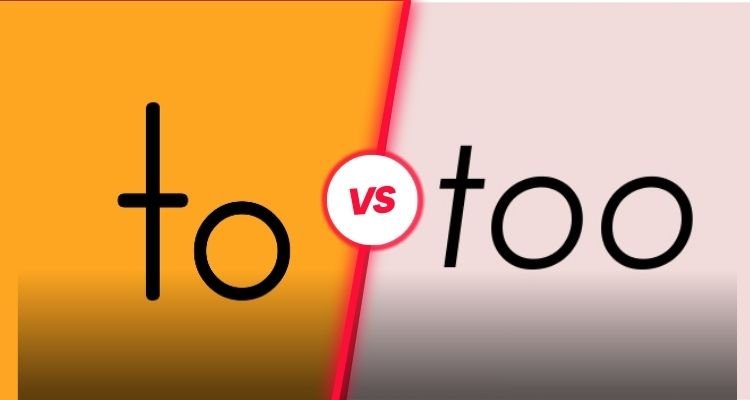The words “to” and “too” are often confused in writing due to their similar spelling, but they have distinct meanings and uses in the English language. Understanding the difference between “to” and “too” is essential for clear and accurate communication.
Definition of “To”
“To” is a preposition that has multiple uses in the English language. It is most commonly used to indicate direction, place, or position, as well as to show purpose or intention. “To” is also used as part of the infinitive form of verbs.
- Key Characteristics:
- Direction or Destination: “To” is used to indicate movement toward a specific place or position.
- Example: “She walked to the store.”
- Purpose or Intention: “To” can indicate the purpose of an action.
- Example: “He went to the gym to exercise.”
- Infinitive Verb Form: “To” is used before a verb to form the infinitive.
- Example: “She likes to read books.”
- Other Uses: “To” can be used in expressions of time, comparisons, and with indirect objects.
- Example: “The meeting is scheduled to begin at 3 PM.”
- Direction or Destination: “To” is used to indicate movement toward a specific place or position.
- Examples:
- “I am going to the park.”
- “They want to finish the project by Friday.”
Definition of “Too”
“Too” is an adverb that is used to indicate excessiveness, addition, or emphasis. It has two primary meanings: “also” or “in addition,” and “more than necessary” or “excessively.”
- Key Characteristics:
- In Addition or Also: “Too” is used to indicate that something is included or added to what has already been mentioned.
- Example: “Can I come, too?”
- Excessiveness: “Too” is used to show that something is more than what is needed or wanted.
- Example: “The soup is too hot to eat.”
- Emphasis: “Too” can be used for emphasis, often to express agreement or support.
- Example: “I think so, too.”
- In Addition or Also: “Too” is used to indicate that something is included or added to what has already been mentioned.
- Examples:
- “She was too tired to continue.”
- “He bought a new car, and his friend did, too.”
Core Differences
Function in a Sentence
- To: Functions primarily as a preposition, indicating direction, place, purpose, or as part of an infinitive verb.
- Too: Functions as an adverb, indicating excessiveness, addition, or emphasis.
Meaning
- To: Indicates movement toward a place, purpose, or action.
- Too: Indicates “also,” “in addition,” or “excessively.”
Usage Examples
- To: “I am going to the office.” (direction)
“She wants to learn French.” (purpose) - Too: “The room is too cold.” (excessiveness)
“I would like some cake, too.” (addition)
Core Similarities
Common in English
Both “to” and “too” are commonly used in everyday English, making them essential for effective communication.
Easily Confused
Due to their similar spelling and pronunciation, “to” and “too” are often confused, especially in written language.
Comparison Table
| Feature | “To” | “Too” |
|---|---|---|
| Function | Preposition or part of an infinitive verb | Adverb indicating addition or excessiveness |
| Indicates | Direction, purpose, place, infinitive form | Addition (“also”) or excessiveness (“more than necessary”) |
| Examples | “I went to the store.” | “She was too tired.” |
Pros and Cons
“To”
- Pros:
- Versatile in use, functioning in various grammatical roles.
- Essential for forming infinitive verbs, indicating purpose, and showing direction.
- Cons:
- Can be easily confused with “too” due to similar spelling and pronunciation.
“Too”
- Pros:
- Useful for expressing addition or excessiveness.
- Helps to clarify or emphasize points in conversation or writing.
- Cons:
- Can be mistakenly used in place of “to,” leading to grammatical errors.
Use Cases and Scenarios
When to Use “To”
- Direction: Use “to” when indicating where someone or something is going.
- Example: “She is driving to the airport.”
- Purpose: Use “to” before a verb to show the purpose of an action.
- Example: “He went to study at the library.”
When to Use “Too”
- Addition: Use “too” when adding something to what has already been mentioned.
- Example: “I want to go, too.”
- Excessiveness: Use “too” to indicate that something is more than necessary or desirable.
- Example: “This coffee is too sweet.”
Summary
In summary, the main difference between “to” and “too” lies in their functions and meanings. “To” is a preposition used to indicate direction, place, purpose, or as part of an infinitive verb, while “too” is an adverb used to express addition (“also”) or excessiveness (“more than necessary”). Understanding the correct usage of these words is important for clear and effective communication in writing and speech.
FAQs
Q: Can “to” and “too” ever be used interchangeably?
A: No, “to” and “too” have different meanings and functions, so they cannot be used interchangeably.
Q: How can I remember the difference between “to” and “too”?
A: Remember that “too” has an extra “o,” indicating “more” or “also,” while “to” is shorter and used for direction or purpose.
Q: What is an example of “too” used for emphasis?
A: “I really like that movie, too.” (emphasizing agreement)
Q: Is “to” always followed by a verb?
A: No, “to” can be followed by a noun, pronoun, or verb, depending on the context. For example, “to the store” (noun), “to him” (pronoun), “to run” (verb).
Q: Can “too” be used at the beginning of a sentence?
A: “Too” is rarely used at the beginning of a sentence. It is more commonly used within or at the end of a sentence for addition or emphasis.

